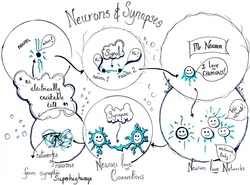Today, you're learning about why planning is so important, and how to organise your ideas better
By the end of the session, you'll understand:
Mind mapping is a great tool to help you revise. It's kind of like what we call a thought shower or a spider diagram but organised. And it's the organisation that makes the difference. Most people don't organise their spider diagrams, so they're just like big, crazy, disorganised lists in a completely random order.
When we organise ideas, we make links in our brain. A link is like a little footpath from one bit of information to another. The more we use it, the more defined it becomes. Our brain has billions of neurons which create synaptic links - the scientific name for these footpaths from one bit of information to another.
By the end of the session, you'll understand:
- why planning is so important
- how mind-mapping can help you revise
Mind mapping is a great tool to help you revise. It's kind of like what we call a thought shower or a spider diagram but organised. And it's the organisation that makes the difference. Most people don't organise their spider diagrams, so they're just like big, crazy, disorganised lists in a completely random order.
When we organise ideas, we make links in our brain. A link is like a little footpath from one bit of information to another. The more we use it, the more defined it becomes. Our brain has billions of neurons which create synaptic links - the scientific name for these footpaths from one bit of information to another.
When we get a new bit of information, we store it away. When we need to access it, the better the connection, the bigger the footpath, the easier it is to access. The more we tread that pathway, and the more ways we access the information, the easier it is to recall. Mind-mapping helps that. Mind-mapping is great for planning essays, organising your revision and studying for exams. Paper mind-mapping is fine. It helps you bring everything together. It's good for visual learners and proper mind-mapping helps you organise the chaos. You can colour-code things, you can organise your information. Use flipchart paper and you can get a whole topic on there in one go. Online mind-mapping takes it up a notch. You can:
Mind42 is great, free software to do this. It allows you to collaborate - so your friends, teachers, students or colleagues can add to it. You can use it on a whiteboard or an ipad as it works with most things. It's also got some great functionality so you can add notes and diagrams and images. Best of all, it's free and it's available on whatever computer you're using when you log on!
The thing it's best at is gathering facts and information. So if you have to revise a knowledge-based subject, it's great for adding lots of information. Here's a simple one I started to help revise An Inspector Calls for an exam. You can colour-code it. You can publish it. You can distribute it. What more do you want?
Good for:
- link up with your friends and mind-map together
- link to files, video, sound, pictures
- add images
- see your mind-map grow
- annotate it
- add notes
- build on it
- access it anywhere if you have a computer or smartphone and a connection
Mind42 is great, free software to do this. It allows you to collaborate - so your friends, teachers, students or colleagues can add to it. You can use it on a whiteboard or an ipad as it works with most things. It's also got some great functionality so you can add notes and diagrams and images. Best of all, it's free and it's available on whatever computer you're using when you log on!
The thing it's best at is gathering facts and information. So if you have to revise a knowledge-based subject, it's great for adding lots of information. Here's a simple one I started to help revise An Inspector Calls for an exam. You can colour-code it. You can publish it. You can distribute it. What more do you want?
Good for:
- Individual revision of factual subjects
- Group work over lots of computers
- Quick recall
- Making links
- Improving your revision

 RSS Feed
RSS Feed